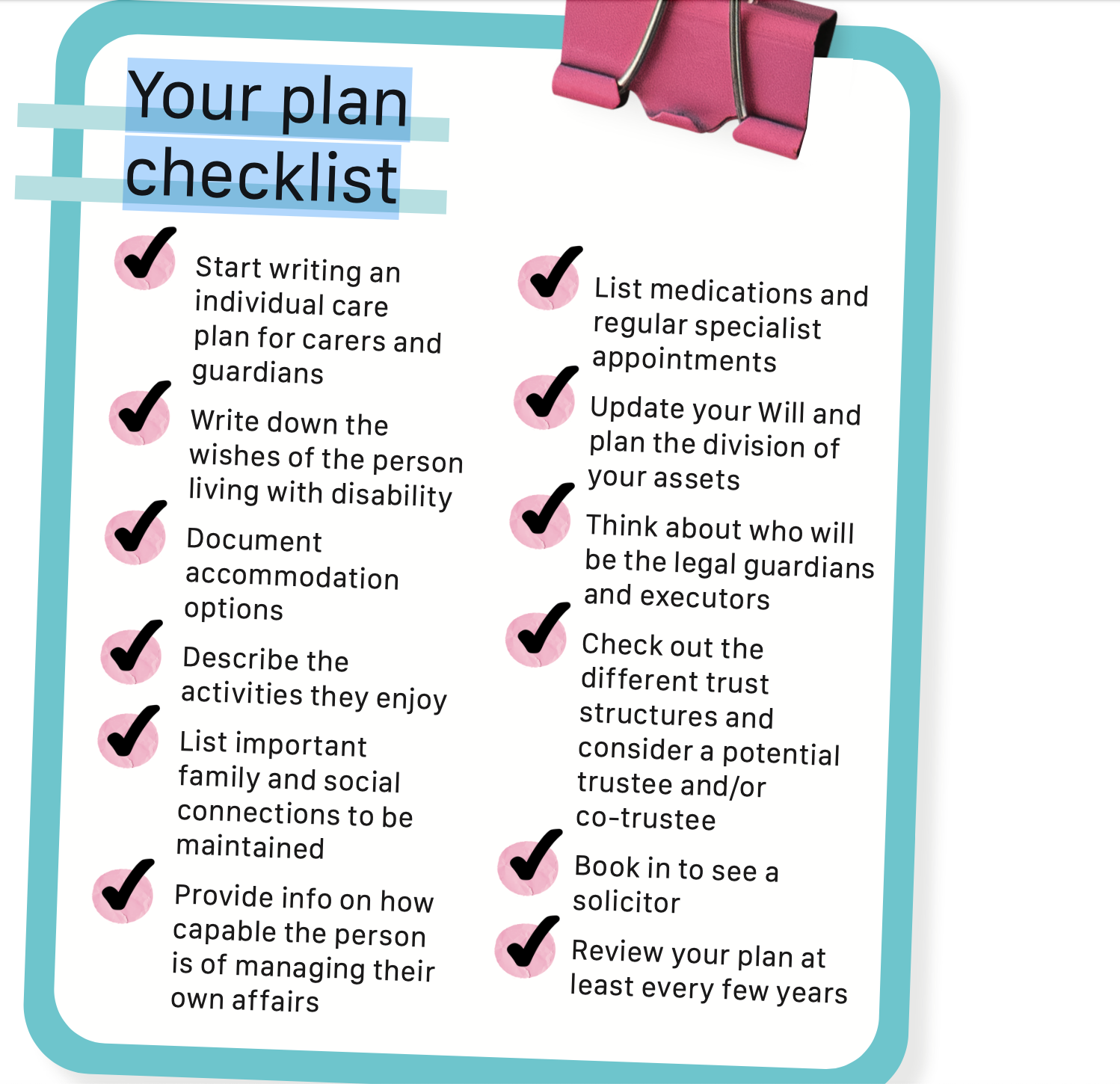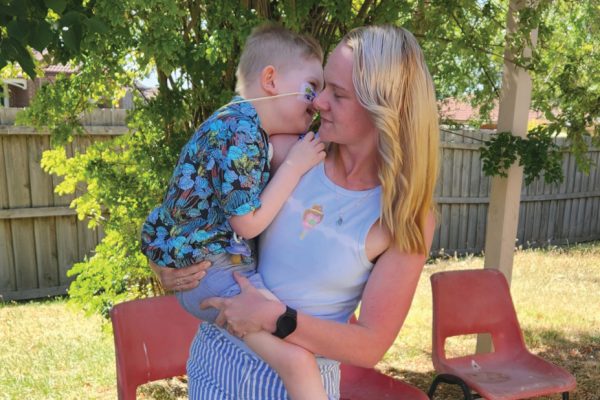
Protecting your child’s future – advice on trusts
By Susan Bonnici
It’s a scenario none of us likes to think about, but estate planning is imperative to ensure your child is cared for and protected says senior estate planning solicitor, Susan Bonnici. And it’s not as complicated as you might think.
What will happen to my child after I am gone or when I am no longer able to care for them?” It’s the thought that has kept many of us awake at night. Will our children be OK financially, and who will look after them?
As an estate planning solicitor by trade, and the mother of a daughter with a rare chromosome deletion called Phelan- McDermid syndrome, I can relate to these feelings all too well.
Only about half of Australian adults have a valid Will. As the parents of a child living with disability, it is vital that families put the right plans in place to ensure that these children are cared for and protected for the rest of their lives.
MAKE A START – HOWEVER SMALL
I know first-hand that having a child with a disability means that adding another task to your to-do list can be overwhelming.
Not only that, the very idea of what life would be like if you weren’t around to do all those things for your child is often simply unbearable. It’s completely understandable that people put their estate planning in the “too hard basket”.
A good way to make a start is to put down some key headings – things such as accommodation needs, activities, social and family connections, their doctors and therapists, medication lists, their school, and their level of independence.
I personally approached it this way – if I was in an accident and a friend or family member had to pick up the care of my daughter, what information would they need to know about her life to ensure they could look after her properly? I developed a Care Plan which set out everything.
In addition to her medical information I also included her likes and dislikes and what will calm her down if she’s upset. My daughter is unable to communicate this information, so it’s important to me that I have it all written down. Obviously, a Care Plan will need to be updated over time as the child’s needs and circumstances change, but just try to focus on the here and now when getting started.
The next step is to think about the legal considerations – how your assets will be dealt with and the care of your child and children will be handled legally if you’re no longer around. I strongly recommend working with a specialist estate planning lawyer who can provide you with tailored advice. Every family is different, so the best legal solution for you will depend upon your assets, your family situation, the needs of the person with disability, and what their future looks like.
YOUR WILL
A Will is your way of guaranteeing that your assets are distributed in accordance with your wishes when you pass away. It’s also your way of ensuring that people you trust are appointed to look after your children (if they are under 18), as well as nominating responsible people to distribute the assets (Executor) and manage any trusts created by the Will (Trustee).
SETTING UP A TRUST
Trusts are frequently used to protect assets for the ongoing benefit of someone who is not able to manage the assets themselves
– this can be because they are children (minors), or people with ongoing health or lifestyle difficulties, including people with disabilities.
In simple terms, a trust is a legal structure where a person or a company, called the trustee, effectively owns assets for the benefit of one or more people, called the beneficiaries.
If you’ve set up your Will in this way, any inheritance your child is entitled to will transfer into their trust and not directly to them. The Will specifies
who will be the trustee, and this person or organisation is legally obliged to manage the trust in the best interests of the beneficiary. By using this approach, parents and carers can be assured that their child’s financial affairs will be taken care of – but deciding whom you appoint as a trustee also requires very careful thought.
CHOOSING A TRUSTEE AND CONSIDERING A CO- TRUSTEE ARRANGEMENT
Some of the factors to consider when deciding who to appoint as the trustee include whether they:
- Have the financial and investment skills to manage the trust assets prudently.
- Have the time and resources required to assess the needs of the beneficiary and comply with the regulatory and compliance requirements of the trust.
- Possess a good understanding of the needs of your child and have the right personal qualities – kindness, patience, integrity and understanding.
- Have any conflicts of interest – a trustee needs to always be impartial and act in the best interests of the person with disability.
- Will be able to act for the duration of the trust – this usually means that they will have to outlive the beneficiary.
- Are trustworthy and responsible and will put the beneficiary’s needs before anyone else’s when administering the trust.
- Will be available to act on a regular basis – it may be impractical if they travel a lot or have their own personal or professional commitments that take up a lot of their time.
While you can choose an individual, who meets all these requirements, there are also good reasons to consider appointing a professional trustee. One reason is that your child is not then relying upon an individual whose health and personal circumstances may change over time. Another reason is that a professional trustee will have access to all the specialised skills and experience required to administer a trust, such as investment advisers, tax specialists, lawyers and trust managers.
A professional trustee also works with strict in-house governance processes for decision-making to ensure the “best interests” test is applied – and if there is a mistake, the penalties are higher because the standard they are held to is higher under the law.
It is also possible to talk to a professional trustee about a “co-trustee” arrangement so that a friend or family member is appointed alongside a professional. In many cases, it can be a happy medium as decisions are made in conjunction with a family-nominated trustee, with the professional trustee taking on the administrative burden.
Every family is so different, and their estate planning solution has to be as unique as they are.

TYPES OF TRUSTS AND OTHER ESTATE PLANNING OPTIONS
There are many different types of trusts, but ultimately the purpose of safeguarding assets with a particular set of instructions for their usage remains the same, these include:
- Special Disability Trust (SDTs)
This type of structure is designed to assist family members to provide for the current and future care and accommodation needs of a family member with severe disability and also meet some of their discretionary spending needs for items such as food, clothing, therapy and recreation.
While these trusts are highly regulated, they do have the advantage of social security means tests concessions for the
beneficiary, and eligible contributors to the trust are also eligible for concessional gifting.
However, there are potential downsides of SDTs to be aware of. Firstly, they have strict criteria for qualifying, and their main purpose is to fund care and accommodation. The beneficiary must have severe disability and their caring needs must be rated as “intense” under the Disability Care Load Assessment. When setting up this type of trust, proof must also be provided that the beneficiary will need care for at least six months, and that the level of care required will be the same, or increased, in the future.
Another limitation of this type of trust is that discretionary spending is capped at $12,500 per year. This may be supplemented by the Disability Support Pension, but it might still be insufficient to meet your child’s needs. As such, if an SDT is viewed as an appropriate strategy, it may be worth combining with another method of support to allow greater flexibility.
- Testamentary Trusts
A testamentary trust allows a portion of your estate to be held in trust for your beneficiary during their life or until they reach a specified age. Testamentary trusts do not have the same constraints as an SDT and can be useful for beneficiaries who do not have severe disability, or provide a fund for other expenses that cannot be supported by an SDT.
A testamentary trust is set up in the Will and enables the trustee to distribute income and capital in a sustainable manner. The trust funds can be used
to acquire accommodation, provide maintenance, support and education; and pay for other expenses, such as holidays. Excess income can also be paid out or retained in the trust. However, unlike SDTs, assets in a testamentary trust will count towards the income and asset test for determining eligibility for social security entitlements.
DIRECT GIFTS
Of course, some people with a disability can independently manage their own personal and financial affairs. In this case, a direct gift may be a suitable strategy. Before making a direct gift, you’ll need to consider the tax implications and the impact the gift will have on your child’s social security entitlements.
It’s also important to understand that legislation and personal circumstances can change. Any direct gifts may need to be managed by a financial attorney or manager if the beneficiary loses mental capacity after the gift is made. Therefore, it is important to understand the level of support they will require before settling on a course of action.
SUPERANNUATION
For many Australians, superannuation
is their biggest asset outside the family home, and many parents opt to leave their superannuation death benefits to a child with disability. Your children can receive superannuation death benefits in a tax-effective manner and can also receive an income stream from the super fund.
You’ll need to review your super nominations and check whether money can go into a trust or can be paid to a beneficiary directly.
COMBINING STRATEGIES
There are a number of options available, and it’s possible that no single strategy will be exactly right for your son or daughter. Combining two or more strategies may be appropriate – but to get it right and provide flexibility for future changes in your child’s needs and capacity, it is important to do your homework and seek the right legal advice.
REVIEW YOUR PLAN
Once you finish your plan and you’re happy with it, make sure you review it at least every couple of years. Remember a lot can change even in a short time – your child’s needs may increase or decrease over time. My daughter is only seven, so what’s right for her now probably won’t be the best solution in five or 10 years’ time. We never know what’s around the corner – medical science may improve our child’s position, or their health may decline resulting in a need for a higher level of care. This is one of the most difficult parts about living with a family member with disability, you don’t know what the future holds. But you can start preparing for it.
Susan Bonnici is a senior estate planning lawyer at Equity Trustees and mother of three, including a daughter with a rare chromosome deletion called Phelan-McDermid syndrome.
Equity Trustees is a specialist in wills and estate planning, developed on a foundation of more than 130 years of experience.






